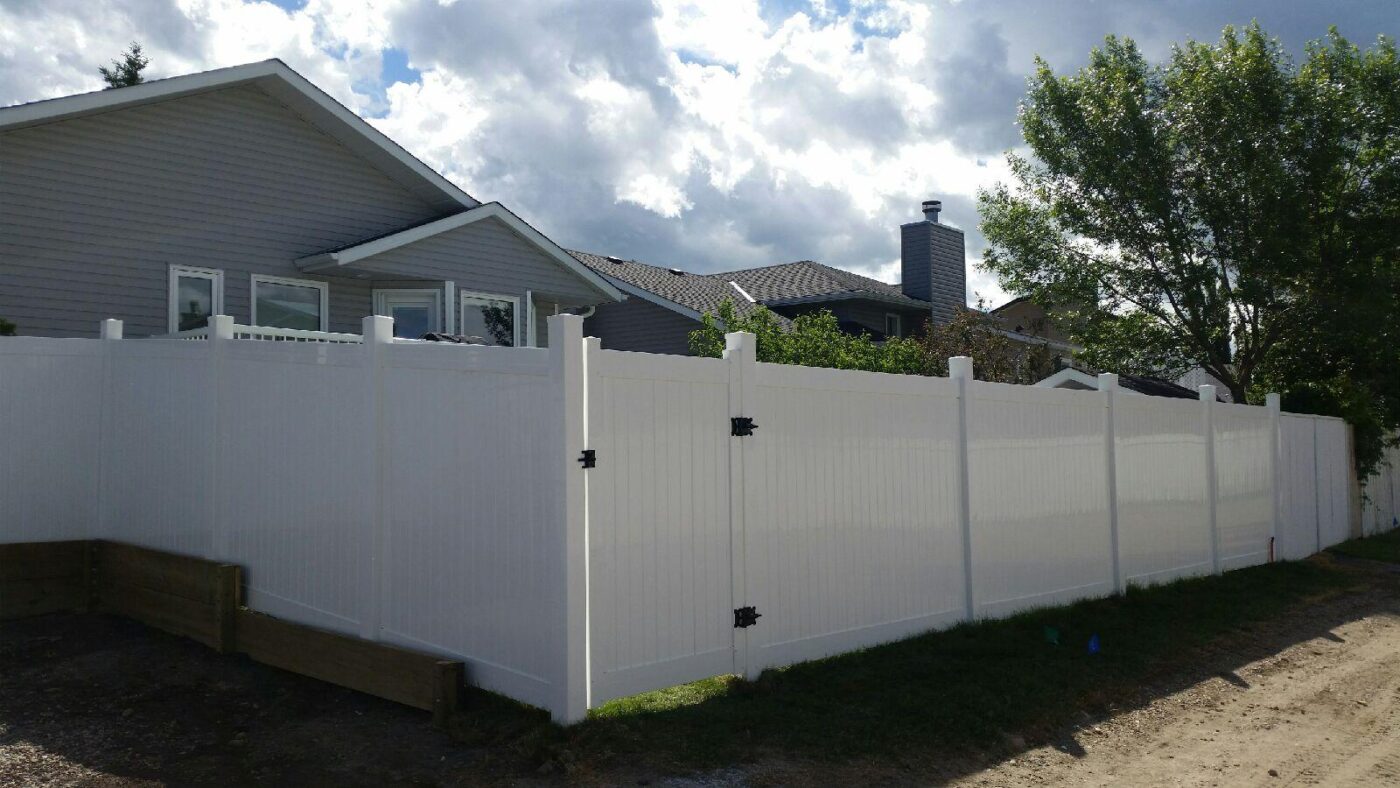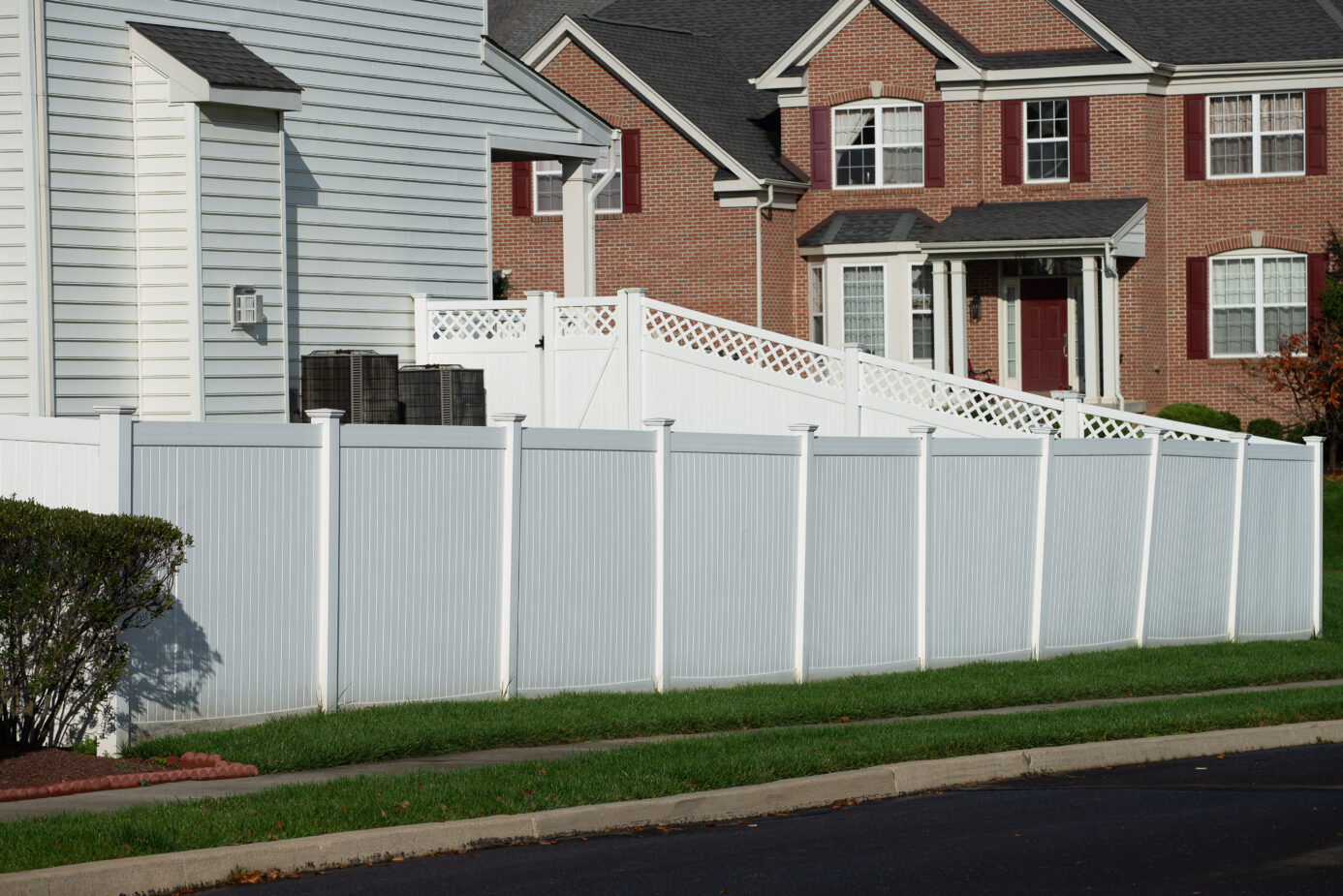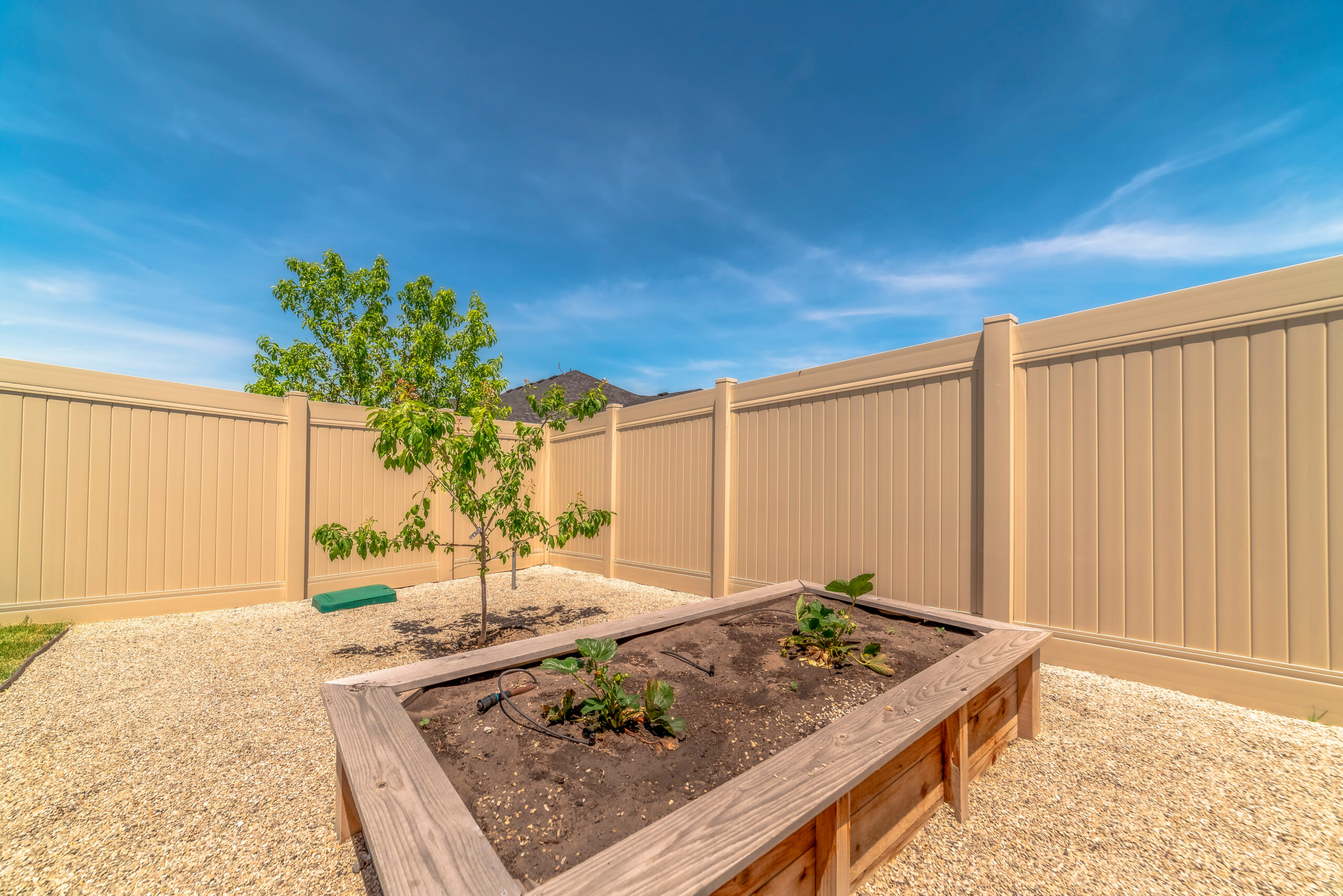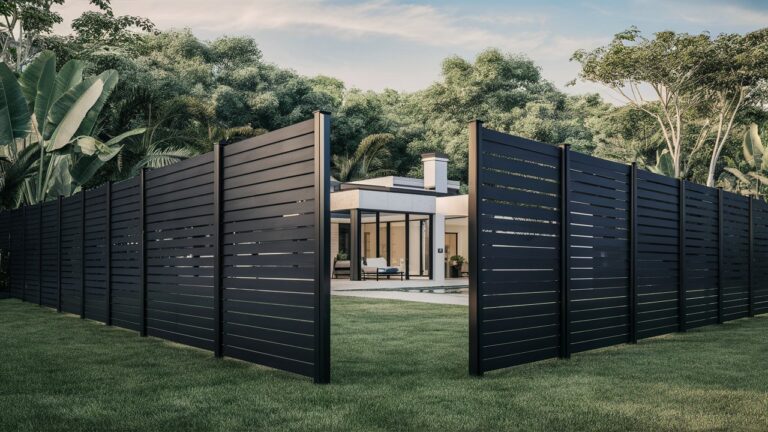Vinyl Fence Benefits
Vinyl Fence is a standout choice for fencing materials, well-regarded for its durability and aesthetic flexibility. We appreciate vinyl fences for their clean and modern appearance, as well as their ability to withstand the test of time.
Unlike traditional wood fences that deteriorate and metal fences that are prone to rust, vinyl fencing maintains its integrity without succumbing to rotting, cracking, or insect damage.
Maintenance of vinyl fence installations is notably straightforward, which we find especially advantageous. The need for repainting, staining, or sealing is non-existent—routine cleaning with soapy water suffices to keep a vinyl fence in pristine condition. Moreover, the installation process is typically quicker and more efficient compared to that of iron or aluminum fencing, which is an aspect we can’t overlook when considering the overall value.
Our recognition of vinyl’s strength and flexibility solidifies its status as a reliable choice for fencing, particularly in areas that experience harsh weather conditions.
Key Takeaways
- Vinyl fencing offers an appealing modern look and diverse design possibilities.
- Our experience confirms the high durability and low maintenance of vinyl fences.
- Safety and ease of installation are key practical benefits of choosing vinyl.
Design and Aesthetic Appeal
When we consider vinyl fencing, two key aspects stand out immediately: its diverse range of styles and the wealth of color and texture options available. We can cater to various design preferences, from the clean look of a traditional white picket fence to the rich texture of natural wood without the associated maintenance.

Variety of Styles
Vinyl fences come in an array of styles to suit any taste or architectural design. We can select from privacy fences that offer a solid panel design to picket styles that add charm and openness to our property. For those of us seeking a more decorative touch, options with unique patterns such as lattice tops provide extra flair while still maintaining the functionality of the fence.
- Privacy Fence: High panels with minimal gaps for seclusion.
- Picket Fence: Available in different heights and picket spacing.
- Decorative Lattice: Often used as a stylish top panel.
The range of styles allows us to enhance our property’s curb appeal and reflect our personal aesthetic.
Color and Texture Options
Our vinyl fencing isn’t limited to the classic white. The spectrum of available colors lets us coordinate with the palette of our home or landscape. From bold hues to more subtle shades, we can choose the perfect color that complements our surroundings. Moreover, texture options allow our fence to exude the beauty and feel of natural materials.
- Traditional White: A clean and timeless option.
- Earthy Tones: Blend with the natural environment.
- Textured Surfaces: Emulate the grains and grooves of real wood.
By selecting from these options, we can ensure that our fence is not only attractive but also aligns with our home’s overall design theme.
Mimicking Other Materials
One of the most appealing aspects of vinyl fences is their ability to mimic other materials. Advanced manufacturing techniques enable vinyl to reproduce the look of natural wood or even stone, delivering the aesthetic we desire without the hassle. This versatility means we can enjoy the attractiveness of traditional materials with the benefits of modern vinyl construction.
- Wood Grain Vinyl: Looks like real wood but requires less upkeep.
- Stone-like Vinyl: Provides the sturdiness of stone with easier installation.
Through these options, we are able to achieve the design and aesthetic appeal we want for our property while leveraging the practical advantages of vinyl fencing.
Durability and Longevity
In our exploration of vinyl fencing, we find that its durability stems from its composition—polyvinyl chloride (PVC)—and manufacturing designed to endure. Let’s examine the specific factors that contribute to vinyl fences’ strength and resilience.
Resistance to Elements
Vinyl fences are inherently strong, capable of withstanding a variety of weather conditions. We recognize that their PVC composition offers exceptional protection against the elements, including extreme weather such as high winds, rainstorms, and harsh sun. The material is waterproof, ensuring that it does not absorb moisture which can weaken other types of fencing. Additionally, UV inhibitors are mixed with the PVC during manufacture, which equips vinyl fences with the ability to resist degradation from UV rays.
- UV Resistance: Equipped with UV inhibitors.
- Waterproof Nature: Does not absorb moisture, preventing weather-related damage.
Insect and Rot Resistance
One of the standout characteristics we appreciate about vinyl fencing is that it does not rot, nor does it attract pests like termites and ants. This is a significant advantage over wooden fences. Being a non-organic material, it is highly resistant to breakdown by mold, mildew, and rot. This resistance contributes to a longer-lasting fence with minimal maintenance requirements.
- Insect Resistance: Resistant to termites and ants.
- Rot Resistance: Immune to mold, mildew, and deterioration due to rot.
No Warping or Fading
We’ve found that vinyl fencing remains stable over time, as it does not warp, crack, or splinter like wood can. Even with years of exposure, a vinyl fence is much less likely to show wear than other materials. The color is also consistent throughout the material, which means scratches or other minor damage are less noticeable and the fence won’t require painting or staining to maintain its appearance. Advanced manufacturing techniques have made newer PVC five times stronger than wood, and colors are now formulated to resist fading over time.
- Strength Against Warping: PVC is inherently flexible and resilient, preventing typical warping.
- Fade Resistance: Advanced color formulations ensure a long-lasting, vibrant appearance.
Maintenance and Upkeep
Vinyl fencing is renowned for its low-maintenance qualities, which save time and money over the long term. We’ll explore the specifics of its upkeep to demonstrate its practical benefits.

Ease of Cleaning
To maintain the pristine appearance of our vinyl fence, routine cleaning is usually sufficient. This minor care can prevent build-up of everyday dirt and grime.
- What you’ll need: A garden hose and possibly some dish soap.
- Frequency: As needed, depending on exposure to dirt and algae.
- Method: Spray down with a hose, and for tougher spots, use a soft cloth with dish soap.
No Need for Painting or Staining
One of the fundamental advantages of vinyl fencing is that it is nonporous, meaning it doesn’t absorb moisture, which typically leads to the deterioration of other materials.
- Painting: Never needed; the color is consistent throughout the material.
- Staining: Unnecessary, as vinyl doesn’t suffer from water stain damage like wood.
Long-Term Cost Savings
Although the initial vinyl fencing cost can be higher than other materials, the savings on long-term upkeep are where we really benefit.
- Repair: Vinyl is durable, so we deal with fewer repairs.
- Labor Costs: Less maintenance equals fewer hours of labor and fewer repair-related expenses.
By anchoring our understanding in these maintenance features, it’s clear to see the practicality of choosing vinyl fencing.
Safety and Comfort
In choosing vinyl fencing, we prioritize not just the aesthetic appeal, but also the safety and comfort it provides to your household. Vinyl fencing is a secure and family-friendly option with features designed to protect both children and pets from common hazards found in other fencing materials.
No Sharp Edges or Splinters
Our vinyl fences are engineered to eliminate the risks associated with sharp edges and splinters—a common concern with wooden fences. We’ve crafted each panel and post with smooth surfaces to ensure that children and pets can play around the fence without the danger of injury. This is particularly beneficial as it reduces the potential for accidents, and no one has to worry about painful splinters when touching or leaning against the fence.
Non-Toxic and Safe
We understand the importance of a non-toxic environment for your family. Our vinyl fencing solutions are made without harmful chemicals, making them completely non-toxic. They do not require treatments with stains or preservatives, which often contain substances that could be unsafe for kids and pets if ingested. Furthermore, vinyl is a flexible material, reducing the risk of injury upon impact. For the environmentally conscious, it’s also worth noting that vinyl fences are often recyclable, contributing to a sustainable, safer home.
Customization and Flexibility
We understand the importance of having a fence that not only secures our property but also complements its aesthetics. Vinyl fencing offers unparalleled customization and flexibility, allowing for tailor-made solutions that cater to particular preferences and requirements.
Variety of Heights and Sizes
Vinyl fences come in a wide array of heights and sizes, enabling us to select the perfect dimensions for our specific needs. Whether we’re looking for a compact fence to accentuate our garden or a taller structure for enhanced privacy, vinyl fencing can accommodate it all.
- Standard heights: 3 ft., 4 ft., 6 ft., 8 ft.
- Custom heights: available upon request to meet unique property lines or landscape features.
Our choice in slat size, from narrow to wide, allows us to further control the level of privacy and design of our vinyl fence panels.
Customizable Accessories
The versatility of vinyl fencing extends to its accessories. We can choose from a variety of post caps and accents to add a distinctive touch to our fence. These customizable accessories not only elevate the look of the fence but also enhance its functionality and lifespan.
- Post Caps: Options include flat, gothic, ball, and solar designs.
- Accents: Lattice accents, horizontal slats, and picket-top features.
Our ability to mix and match these details ensures that our vinyl fence is as unique as the property it protects.
Environmental Impact
In our examination of vinyl fences, we’ve identified crucial benefits pertaining to environmental sustainability. These fences, constructed mainly from PVC—a type of plastic-based material—merit consideration for their eco-friendly qualities and ability to reduce landfill waste.

Eco-Friendly Material Options
Vinyl fencing, often made from PVC (polyvinyl chloride), presents a compelling eco-friendly choice. The key lies in its foundation of recycled materials, allowing us to participate in a circular economy that continuously reuses finite resources—reducing our ecological footprint. It’s noteworthy that PVC is both non-toxic and recyclable; thus, at the end of its lengthy lifespan, a vinyl fence doesn’t have to become environmental waste. Instead, it can be repurposed, mitigating the demand for new raw materials.
- Recycled Content: A large percentage of vinyl fences comprise recycled PVC, aligning with our green goals.
- Recyclability: Post-consumer vinyl can be collected, processed, and transformed into new fencing products.
Reduced Waste in Landfills
We are committed to reducing contributions to landfills, and vinyl fences align with this ideal due to their durable nature and longevity. Vinyl fencing typically outlives traditional wood fences, thereby minimizing frequent replacements and cumulative waste. Each time we opt for a vinyl fence, we’re effectively:
- Extending Product Lifespan: The inherent endurance of vinyl material lessens the frequency of fence replacements.
- Diminishing Landfill Load: Fewer replacements translate into less waste, thus we conserve valuable landfill space.
By investing in fences made from recyclable, plastic-based materials like vinyl, we’re not only enhancing the aesthetic and functional values of our properties but also fostering a more sustainable environment for future generations.
Comparisons with Other Fencing Materials
In our analysis, we consider the performance, maintenance, and cost attributes of vinyl fencing relative to other popular materials such as wood, aluminum, and chain link.
Vinyl vs. Wood Fencing
Durability and Maintenance:
Wood fences have a traditional appeal but can crack and splinter over time. Our vinyl fencing counterparts offer a durable option that doesn’t suffer from the same issues. Wood is susceptible to rot and insect problems, while vinyl is impervious to these concerns. In terms of maintenance, vinyl fences require a simple cleaning routine as opposed to wood, which may require refinishing or repairs due to weathering.
Cost Effectiveness:
Initially, wood fences may present a lower upfront cost compared to vinyl. However, over a longer period, the low maintenance requirements of vinyl can make it a more cost-effective solution despite its higher initial investment.
Vinyl vs. Aluminum and Wrought Iron
Strength and Aesthetics:
While aluminum and wrought iron fences offer strength and a distinct appearance that can enhance the property’s value, they can be prone to rust over time. In contrast, we find that vinyl fencing will neither rust nor fade, maintaining its look without the need for repainting or anti-rust treatments.
Installation and Cost:
Comparatively, aluminum fencing can have a slightly higher cost than vinyl, but both are more expensive than materials like chain link or wood. The installation of vinyl is usually straightforward, though less elaborate than wrought iron, which may require specialized installation.
Vinyl vs. Chain Link Fences
Privacy and Appearance:
Chain link fences are known for their affordability and durability. However, they offer little in terms of privacy and can appear more utilitarian. Our vinyl fences provide a solid barrier for privacy and come in various styles, catering to aesthetic preferences beyond the functional aspect.
Maintenance and Lifespan:
With a chain link, there is potential for rust, while our vinyl fencing options are virtually immune to such degradation. The expected lifespan of a properly maintained vinyl fence often surpasses that of chain link, making it a lasting addition to a property.
Considerations Before Choosing Vinyl
When we consider installing a vinyl fence, it’s important to weigh its strengths and weaknesses, understand the associated costs, and be aware of potential downsides. Each of these factors plays a critical role in our decision-making process.
Pros and Cons of Vinyl Fencing
Strength and Maintenance:
- Pros: Vinyl fencing is known for its durability and longevity. It doesn’t require staining, painting, or sealing and can be cleaned easily with soap and water. This low maintenance can save us time and money in the long run.
- Cons: In rare cases, vinyl may become brittle and susceptible to damage in extreme temperatures. Also, if a panel gets damaged, we often need to replace the entire section rather than individual slats.
Privacy and Security:
- Pros: The solid panels of a vinyl privacy fence offer complete privacy and can also provide a secure boundary for our property.
- Cons: If privacy or security becomes compromised due to damage, immediate replacement of sections may be necessary, incurring additional costs.
Cost vs. Value Analysis
Vinyl fencing cost is a key consideration in our project planning. On the front end, vinyl fencing is often more expensive than wood. For example, the average installation cost of a 150-linear-foot vinyl fence is about $8,750, compared to $7,900 for the same length in wood. However, we need to balance this initial quote against the long-term value, factoring in the minimal maintenance costs and replacement frequency.
Cost of Repairs:
While repairs are not often required, they can be costlier due to the need to replace larger sections instead of individual parts.
Assessing the Downsides
Despite the benefits, we should also be mindful of a few downsides.
- Color Fading: Lower-quality vinyl options may experience color fading over time, especially when exposed to prolonged sunlight and harsh weather conditions.
- Installation Factors: We must consider our property’s specific needs. This includes slopes and obstructions that could impact installation complexity and costs.
- Regulatory Compliance: It’s crucial to adhere to local zoning laws and regulations. This will help us avoid potential penalties or the need for modifications regarding fence height and style.
By staying informed on these specifics, we can ensure a well-rounded decision-making process regarding the installation of a vinyl fence on our property.


